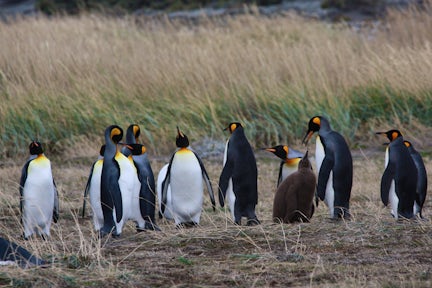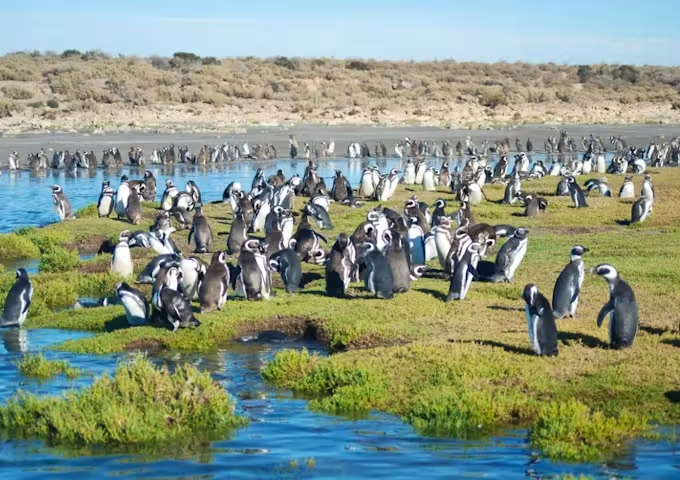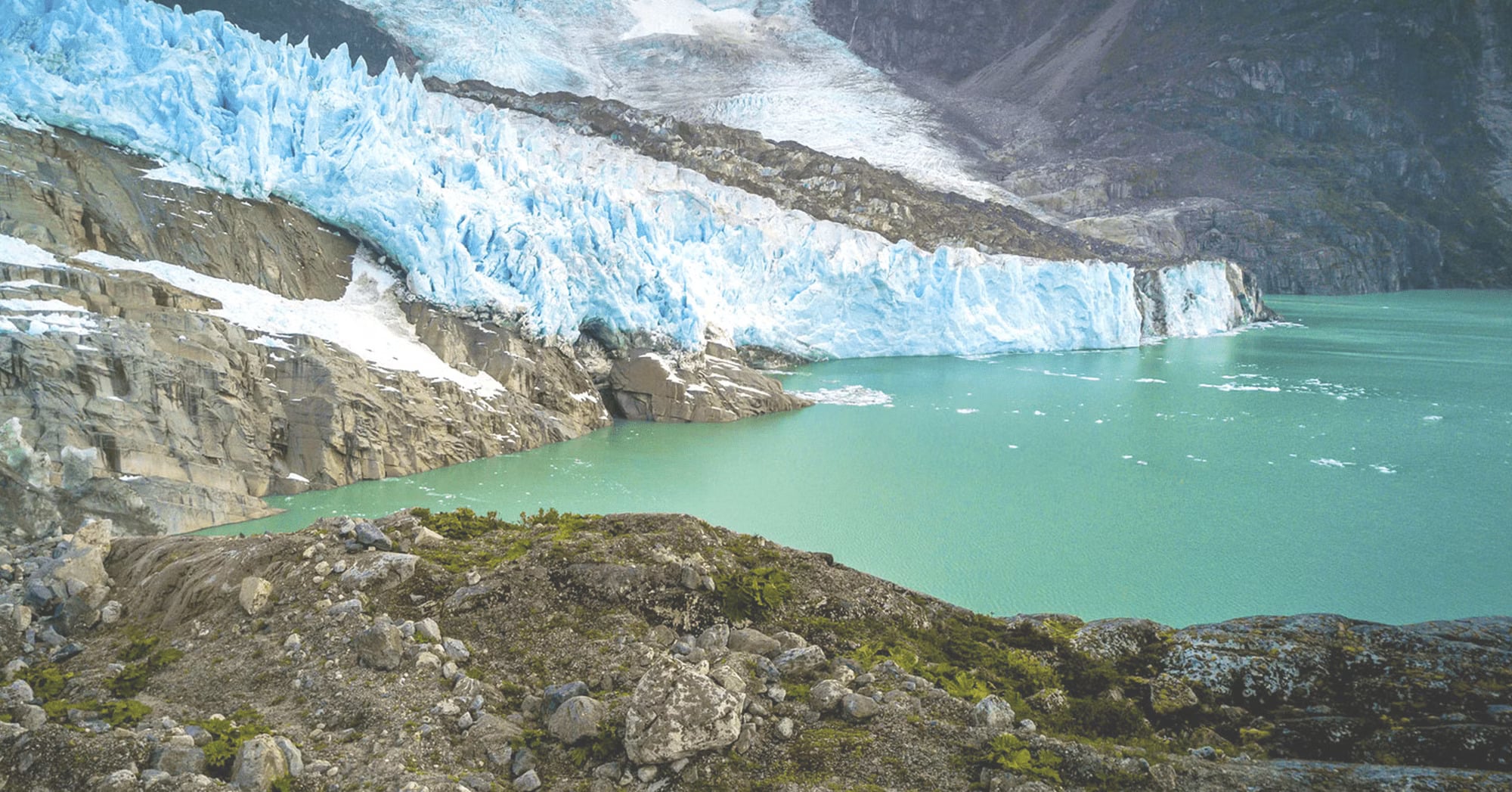Exploring a Magellanic penguin colony
Types of Penguins in Patagonia
Magellanic Penguins

Closely related to the African Penguin, Magellanic Penguins are the only migratory, offshore foraging species. They are migratory birds, moving north in the winter months, often as far as Peru or Brazil. Magellanic penguins generally breed in burrows or under bushes, in a variety of habitats from low forests to grassland to bare rocks, often on islands or headlands. Some colonies on the Argentinean side number several hundreds of thousands of pairs. Their diet is fish based: mainly anchovies and sardines, supplemented by cephalopods.
King Penguins
Second largest and similar in appearance to the Emperor penguin, King penguins have dark orange cheeks, white bellies, and light grey backs. They live in dense colonies, maintaining territories within pecking distance of each other amongst tussocks & sloping beaches. Adults rear up to two chicks every three years, and no other bird has a longer breeding cycle! They take 14-16 months to fledge a single chick, which may be left to fast for up to 5 months during winter (May- September). Their diet is more specialised than other penguins - they prefer pelagic fish such as lanternfish which make up over 99% of their diet.

Kings rock their pristine coats
Gentoo Penguins
Gentoo penguins can be identified by their orange/red lower mandible, and the white patch above each of their eyes (after 14 months of age). They are closely related to Chinstrap and Adelie penguins but usually live in smaller colonies that are less densely packed. They tend to stay close to their colonies all year round, but vagrants have been found in various locations. Their diet varies depending on where they are living, but generally consists mainly of crustaceans (particularly Krill), as well as benthic fish and occasionally squid!

Humboldt Penguins
Humboldt Penguins overlap breeding grounds with Magellanic Penguins around Puerto Montt and the island of Chiloe. They look very similar to Magellanic penguins, but without the secondary black breast band and wider white band around the head. Humboldts also have more extensive areas of bare facial skin, including a pink fleshy patch at the base of the lower mandible. They nest in burrows, often dug into thick guano deposits, among boulders, in sea caves and occasionally in the open, and tend to forage on shore, close by to the colony after sunrise. Their diet is based on small schooling fish such as anchovies and sardines, supplemented with the occasional squid!

Rockhopper Penguins
The rockhoppers name refers to the two-footed hops they make as they move up and down the paths of the nesting colony. Rockhoppers are confident little penguins and show little fear of people or larger animals. They feed on krill, squid and fish which they swim to depths of 100m to catch. They nest in colonies on top of sea cliffs. Pairs will return to the same spot each year in October and lay two unequal sized eggs in November, they will usually only raise one chick, the one that hatches from the bigger egg. The male will provide most of the incubation and brooding duties, staying at the nest, fasting, whilst the female finds food for the chick. Once the chick joins the creche with the other young, the male will forge for food too. After ten weeks the chicks will fend for themselves, at this point the adults undergo a 25 day moult before leaving the colony.

Trips where you'll see Magellanic Penguins
Where to Spot Penguins
Bahia Inutil
A new colony of King penguins has been establishing in Tierra del Fuego. It is the only King Penguin colony outside of the Sub-Antarctic islands and is therefore very unique and special. You can visit this colony on a one day trip by plane or two day trip by ferry from Punta Arenas. You can observe and photograph these colourful metre tall penguins going about their business from a purpose built hide that keeps the penguins from getting disturbed or distressed.

A small group of Southern Rockhopper penguins have also started to join the King Penguins at Useless Bay. Like the Kings, the Rockhoppers are in abundance in the Sub-Antarctic islands but rarely seen in South America, however, it appears they have started using Bahia Inutil as a place for their post-breeding moult.

Isla Magdalena & Isla Marta
Isla Magdalena is home to a colony of around 120,000 Magellanic penguins. You can walk amongst them (within roped off areas to preserve their habitat) for around an hour.
Isla Marta is home to over 1000 sea lions, a variety of bird species, a group of elephant seals, and a colony of Magellanic penguins. You can circle the island by boat but are not allowed to disembark.
You can access these islands on a day trip by ferry or zodiac boat from Punta Arenas, or on a three or four night adventure cruise between Punta Arenas and Ushuaia.
You can visit this reserve from October to March, with the most penguins being seen between November and January. Outside of these months you will see fewer individuals as they will have migrated to the sea.

Observing Magellanic penguins from a zodiac in the Chilean fjords
Tucker Islets
The only way to visit this Magellanic penguin colony is by joining one of the weekly expedition cruises between Punta Arenas and Ushuaia. These cruises take you on a zodiac boat trip among the network of islands that house this colony, and although you cannot get off and walk among them, your zodiac boat will beach on the shores of several of the islands so that you can get within a metre or two of the curious little birds!

Cormorants, Tucker Islets
Martillo Island
Martillo Island is accessed from Ushuaia, Tierra del Fuego. It is a very special place because it is home to two (sometimes three!) different penguin species: Magellanic, Gentoo and the odd King penguin!
The island can be visited as part of a 6 hour boat trip from Ushuaia takes you up the Beagle Channel to Martillo Island and back. You visit a sea lion colony, a nesting island for Cormorants, the famous lighthouse called Les Eclaireurs, and of course Martillo Island itself. The boat beaches at the island, where you can view the penguins from onboard. A great trip for bird watchers and nature lovers in general.

Punta Tombo
The Valdes region is home to an abundance of wildlife, and several penguin colonies. The most well-known and popular colony is at Punta Tombo, which is home to the the largest Magellanic penguin colony in the Americas. Approximately one million penguins come here each year to roost between September & March. Penguin watching tours head here from both Puerto Madryn and Trelew, or you can drive there independently with a hire car. The best time to visit is between October and March, but it can be quite busy and touristy.

Magellanic penguins on Peninsula Valdés
Chiloe Island
The beautiful island of Chiloe is host to two different breeds of Penguins, who nest on three rocky islands accessible from the lovely beach of Punihuil. It is in fact, the only place where both Magellanic and Humboldt penguins nest together! You could choose to take a day trip to the island from Puerto Varas or to spend a night or two on the island itself.
Photo © Enrique Couve

Trips where you'll see King Penguins

What Our Customers Think of Patagonia Penguins
Patagonia Penguins trips scored 4.1/5 from 69 reviews
Review:
Penguin FAQs
-
What are baby penguins called?
Baby penguins are called chicks. When they are born they have a coat of light feathers, which later moults into their waterproof plumage. They grow on a diet of food regurgitated by their parents, and when they begin to walk around, they gather in groups known as crèches, waiting for the adults to return from sea to feed them.
Once they are strong enough to venture out on their own, to feed, swim and socialise, they set off from the colony until they are ready to breed. This can be 2-5 years, depending on the species.
-
What’s the smallest penguin species?
The smallest known penguin species is the Little Blue or Fairy Penguin, standing at an average of 16 inches. There is a huge variation between species - the largest living species of penguin is the Emperor, which reaches 47 inches in height.
-
What do you call a group of penguins?
In water, a group of penguins is known as a 'raft', and on land, a 'waddle'. There are also other collective nouns for penguins on land, including a 'rookery', 'colony' and 'huddle'. Penguins are colonial birds as they nest and breed in close proximity as a group - even at sea, they tend to swim and feed in groups.
Penguin colonies are very large; in South America colonies consists of thousands of individuals, in Antarctica they can reach the millions in number.
-
Where can I see penguins in South America?
Across Peru, Ecuador, the Falkland Islands, Argentina and Chile, seven species of penguin can be seen.
Within Patagonia, the South American Magellanic penguin spends the summer months in both Argentina and Chile, migrating north in winter. The fastest growing colony in South America is at Punta Norte, and the biggest at Punta Tombo - you'll be able to walk alongside thousands of penguins as you explore the reserve. In the Valdes Peninsula, the Magellanic shares it's home with countless other animals of the land and sea.
The area around Puerto Montt and Chiloé island holds a unique claim as the only place in the world where Magellanic and Humboldt penguins nest together. If you want to see Rockhopper penguins, Puerto Deseado is your place, whereas Martillo Island is the favoured residence for the Gentoo penguin.
The majority of penguin species, and the largest colonies, inhabit Antarctica or the surrounding sub-antarctic islands. Most trips to Antarctica depart from Ushuaia, the southernmost point of Argentina, so you could easily coordinate some time in Patagonia with a cruise to Antarctica.
-
How fast can penguins swim?
Penguins are known as the fastest-swimming (as well as deepest-diving) species of bird. Most make their way through the water at speeds of 4-7mph, although Gentoo penguins can top 20mph! See these rapid swimmers on a boat trip to Martillo Island, a 15 minute journey from Ushuaia.
Swoop. Your adventure story.
The Patagonia experts
We are guides, guardians, and travellers with over 400,000 hours of lived experience in Patagonia.
Any adventure, so long as it’s yours
From a world of options, we’ll help you discover your perfect trip.
B Corp certified
We care deeply about protecting Patagonia, that’s why 1% of our revenue goes to conservation.
With you at every step
Our dedicated support throughout will make sure you have the experience of a lifetime.
Patagonia Wildlife Guide

Discover Specialist Trips
Patagonia offers an array of unique adventures catering for all variety of activities. At Swoop we pride ourselves on being adventure specialists whether that adventure be kayaking, mountain biking, horse riding, birdwatching, puma tracking, fishing, climbing, mountaineering or rafting.
Ready to plan your Patagonia adventure?
Listen
We'll spend some time listening to your aspirations, then discuss the kind of experience that might suit you.
Match
Next we'll discuss the options, shortlist the best trips for you and present you our impartial recommendations.
Reserve
We'll place a 24 hour hold on your preferred option - without obligation - whilst we talk through the details.
Whatever your budget, group size, length of stay, preferred activity or appetite for adventure, we can help.
1 888 970 4571










.JPG?auto=format,enhance,compress&fit=crop&crop=entropy,faces,focalpoint&w=680&h=480&q=40)









